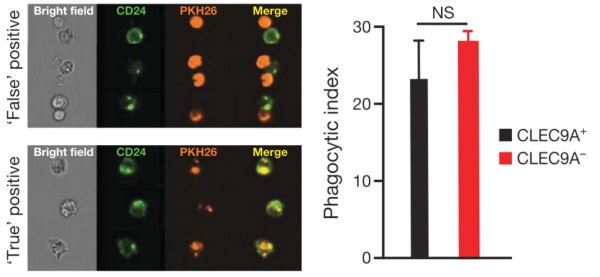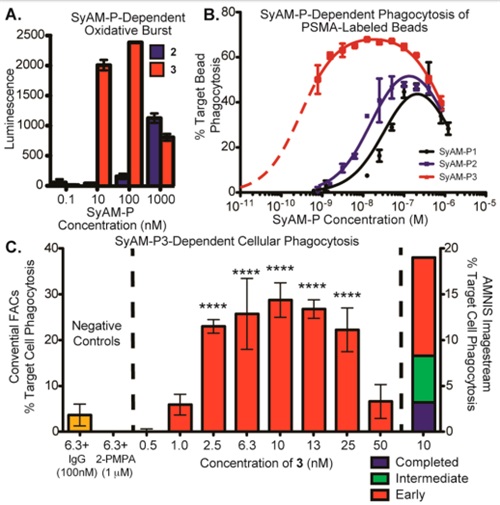The latest hot applications of the new generation of imaging streaming technology
In recent years, life science research tools have been continuously updated, and a new generation of cutting-edge technologies such as sequencing, imaging, and automated testing have revolutionized the cognitive dimension of the entire life science industry, not only making new breakthroughs in enduring scientific research topics, such as intercellular interactions. Roles, autophagy, and cellular signaling pathways have also provided new ideas for some of the problems that could not be solved in the past, such as the new cancer therapy CAR-T. This paper selects high-level literatures such as Nature and Science to explore the application of a new generation of imaging streaming technology in the following hot topics.
Immune cell engulfment
Intercellular interactions have always been a hot spot in immunology. Immune cells can phagocytose target cells to achieve self-repairing functions, and can also exchange substances between different cells through receptor ligand binding. Because traditional methods cannot image individual cells, there has been a lack of intuitive and effective evidence of the way cells interact. On April 16, 2009, David Sancho et al. published an article entitled "Identification of a dendritic cell receptor that couples sensing of necrosis to immunity" on Nature, successfully confirming the coupling of dendritic cells via SKY. The C-type lectin receptor CLEC9A recognizes and phagocyts necrotic cells and uses quantitative imaging flow cytometry to identify and quantify statistical cellular phagocytosis.

Figure 1: The cell-adhesive ('False' postive) and phagocytic cells ('True' positive) can be clearly discerned by the left-side imaging flow pattern, thereby eliminating the interference of false positive results.
Signal Transduction
In addition to phagocytosis of immune cells, intercellular interactions also involve intercellular signal transduction by different cells through the binding of ligand receptors. The most common is the formation of immune synapses between T lymphocytes and antigen presenting cells in an adaptive immune response. In normal cells, proteins associated with immune synapse formation, lymphocyte function-associated antigen-1 (LFA-1), cell surface antigens CD3, and F-actin are evenly distributed on the cell surface; these proteins are formed when immune overhangs are formed. Aggregation occurs at the point where the two cells are in contact. It is according to this mechanism that in 2009, Babak H. Hosseini and others successfully used imaging flow cytometry to detect HEL peptide-treated cells to promote the formation of immune synapses, and published the research results on PNAS. This also demonstrates the unique advantages of imaging flow in detecting immune synapse formation.

figure 2:
Figure 2A shows that LFA-1, CD3 and F-actin did not agglutinate in samples that were not treated with HEL polypeptide and therefore did not have immunological synapse formation. After the cells were treated with HEL polypeptide, LFA-1, CD3 and F-actin coagulated and proved to have immunological synapse formation.
The quantitative statistics of Figure 2B show that the results of HEL polypeptides promoting immune synapse formation are statistically significant.
Autophagy
Autophagy is a catabolic process that remains in the process of evolution and evolution. It mainly transports substances in the cytoplasm to the lysosome and is then catabolized, thereby realizing the metabolic needs of the cells themselves and certain organelles. Update. The traditional method of studying autophagy is mainly to observe the formation of autophagosome/autophagic lysosomes by fluorescence microscopy or confocal microscopy. Due to the limited field of view of the microscope, high-throughput samples or mixed cell samples, such as clinical blood samples, cannot be analyzed. In 2012, Kanchan Phadwal et al., "Automatic" published "A novel method for autophagy detection in primary cells" using quantitative imaging flow cytometry to quantify autophagy in human blood, and by primary cells The autophagy activity of T-cells was significantly higher than that of B cells, and the autophagy of CD8+ T cells decreased significantly with the increase of DNA damage. This provides a reasonable explanation for the decline in immune system function with age.

Figure 3: It can be seen from the figure that the cell LC3 in which autophagy occurs is aggregated within the cell, so within the cell, the fluorescent signal is a scatter. After the addition of the inhibitor (Basal+I), autophagy is inhibited, so LC3 is diffusely distributed within the cell. |
CAR-T immunotherapy
New anti-tumor drugs have always been the focus of research and development of major pharmaceutical companies. Most of the anticancer drugs currently in clinical use are chemical drugs, and such drugs often cause serious adverse reactions and drug resistance due to poor targeting. Although pharmaceutical companies have invested a lot of manpower and resources, they have to admit that the development of traditional chemical anti-tumor drugs has encountered bottlenecks. More and more researchers are turning their attention to immunotherapy, so chimeric antigen receptor T cell immunotherapy (CAR-T) has become the "darling" of scientific research. Unfortunately, most antigens expressed by tumors are not tumor specific, so most CARs target tumor-associated antigens, but this often leads to the possibility of "off-target". At the same time, cell surface antigens need to be selected for related antigen selection to avoid the possibility of CAR-T off-target. Therefore, the search for tumor-specific cell surface antigens has become the key to CAR-T research. Bryan W. Day et al. found that receptor tyrosine kinase overexpresses EphA3 in patients with glioblastoma multiforme (GBM) and reduces tumor cell differentiation by modulating the mitogen-activated protein kinase signaling pathway. Fortunately, the authors have detected EphA3 as a membrane protein by quantitative imaging flow cytometry, a finding that provides potential therapeutic targets for subsequent CAR-T studies.

Figure 4: The distribution of EphA3 labeled fluorescently by imaging flow image, mainly on the cell membrane, and highly expressed in Integrin α6 and CD133 positive cells. Statistical analysis of these cells confirmed that high expression of EphA3 was statistically significant. |
Although the development of traditional chemical anti-tumor drugs has encountered bottlenecks, chemical modification is relatively simple and convenient, and chemically modified antigen-antibody specificity and affinity will be improved; therefore, chemical modification remains in the CAR-T study. Has great application potential. Yale University's Patrick J. McEnaney et al. designed and synthesized a class of compounds called "synthetic antibody mimics targeting prostate cancer (SyAM-P)". These medium molecular weight (~ 7000 Da) compounds also have antibody binding. The ability to effect, therefore, can effectively combine immune cells and prostate cancer cells, thereby enhancing the specific recognition and phagocytosis of cancer cells by immune cells. The discovery was published on the 16th December 2014 issue of JACS, the authoritative journal of chemistry, providing new ideas for CAR-T research.

Figure 5: The phagocytic cells can be distinguished by imaging flow. The phagocytic map (bottom right) shows that SyAM-P can help immune cells recognize cancer cells; the phagocytic completion map (top right) demonstrates that immune cells can phagocytose cancer cells. Quantitative analysis on the left shows that the results are statistically significant. |
In summary, we can easily find that a single image or a single population statistical data can no longer meet the needs of scientific research. Especially in the era of rapid development of precision medicine, scientists need to obtain higher quality and more credible data to provide strong support for clinical diagnosis and treatment. Therefore, it is not only necessary for researchers to combine individual data with group data, but also to confirm the statistical results obtained by “seeing is believingâ€. Quantitative imaging flow technology combines flow cytometry with fluorescence microscopy to provide both cell population statistics and individual cell images, providing cell morphology, cell structure, and subcellular signal distribution. The complete information, which indicates the unlimited application potential of this technology in the future research field!
Request the full text of the article in this article>>
Amnis ImageStreamX MarkII platform with quantitative imaging streaming technology
Combining the statistical power of the flow with the morphological depth of the fluorescence microscope allows you to break through the single data model of the “scatter plot†and provide you with over 100 quantitative imaging parameters based on traditional flow fluorescence signal strength parameters. Used to perform analysis of different cell populations.

* The next generation of "Pioneer" flow cytometry, a milestone epoch-making product in the history of streaming development;
* Pioneer-level hardware configuration, up to
* 7 lasers, 5MESF limit level fluorescence sensitivity, top level resolution;
* True multi-parameter analysis, providing more than 100 quantitative parameters per cell for more comprehensive and deeper streaming data;
* In addition to a single parameter of fluorescence intensity, it also provides accurate imaging judgments, which can achieve high-content data analysis results of tens of thousands or even hundreds of thousands of cells at a time;
* Numerous unique applications, intercellular interactions, protein localization, endocytosis, nuclear translocation, etc., from flow cytometry to a comprehensive platform for individual and population functional research.
Visit the Amnis Quantitative Imaging Streaming Technology website >>
Â
references:
1. Sancho, D., et al. , Identification of a dendritic cell receptor that couples sensing of necrosis to immunity. Nature , 2009. 458(7240): 899-903
2. Hosseini, BH, et al. , Immune synapse formation determined interaction forces between T cells and antigen-presenting cells measured by atomic force microscopy. Proc Natl Acad Sci USA , 2009. 106(42): 17852-7
3. Phadwal, K., et al. , A novel method for autophagy detection in primary cells. Autophagy , 2012. 8(4): 677-689
4. Day, BW, et al. , EphA3 Maintains Tumorigenicity and Is a Therapeutic Target in Glioblastoma Multiforme. Cancer Cell , 2013. 23(2): 238-248
5. Bezbradica JS, et al. A role for the ITAM signaling module in specifying cytokine-receptor functions. Nature Communication, 2014. 15(4): 333-342
6. McEnaney PJ et al. Chemically Synthesized Molecules with the Targeting and Effector Functions of Antibodies. JACS, 2014. 136: 18034 - 18043.
Merck Life Sciences
Tel: 400-889-1988 turn No. 2
Email: china.marketing.
Multi Functional EVA Safety Shoes
Dongying Hongxing Labor Protection Products Co., Ltd. was established in December 1995 with a registered capital of 300 million yuan and total assets of 230 million yuan. It has 520 employees, including 22 professional and technical personnel, with a sales volume of 280 million in 2019. Yuan is a private enterprise integrating R&D, production and sales of labor protection products. The company has a professional R&D team, standardized production lines and quality testing facilities. The company produces and operates more than 1,000 products in 30 categories, including Body Protective Clothing, etc., which can meet the comprehensive needs of labor protection from Head Protective Cap to Foot Protective Shoes , that is, labor protection from head to toe. The company has successively become a director unit of the Occupational Health Protection Products Committee of China Textile Business Association, a member unit of China Labor Protection Products Alliance, a member unit of Shandong Labor Protection Products Industry Association, and a top 50 enterprise in the national labor protection industry; Anbeier brand has become Shandong Labor Protection Products Industry Association Recommended Brand. Labor protection products such as Body Protective Clothing and Hand Protective Gloves produced by the company can meet the multi-faceted needs of laborers, and various Daily Washing And Chemical Articles can meet the all-round needs of various companies. Welcome to consult and purchase.
Multi Functional Eva Safety Shoes,Eva High-Low Safety Single Work Shoes,High-Low Safety Single Work Shoes,High And Low Top Safety Work Shoes Cotton
Dongying Hong Xing Labor Protection Products Co.,Ltd. , https://www.hongxinglabor.com





